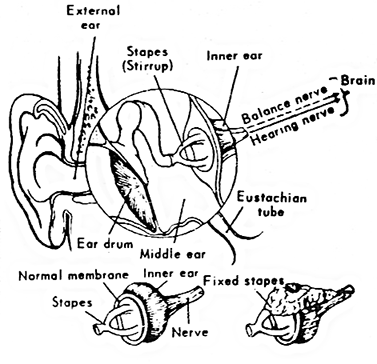The Lippy Group is a globally recognized expert in treating otosclerosis. The Lippy Group began performing stapedectomies in 1960, and has since successfully performed thousands of procedures. Patients have traveled from across the country and around the world to be treated by our surgeons. Dr. Lippy (who is now retired) and Dr. Berenholz (who joined the practice in 1998) have developed many techniques to refine stapedectomy, and have also written numerous papers and book chapters on the topic of stapedectomy surgery.
HOW WE HEAR
The middle ear is divided into three parts: the external (the outside and the ear canal); the middle (the eardrum and three ear bones); and the inner (the hearing and balance nerve endings). Sounds travel through the ear canal to the eardrum. The eardrum and the three small bones transmit sound vibrations through the middle ear to the inner ear. These vibrations are transformed in the inner ear by nerve endings and are transmitted in the form of electrical energy to the brain. The inner ear and brain enable sounds to be heard and words to be distinguished clearly.

The chain of small bones in the middle ear are called ossicles. Of the three bones in this chain, the bone nearest the inner ear is shaped like a stirrup and is called the stapes (stay-peas). Otosclerosis is an abnormal growth of bone around the stapes which hardens and eventually stops the movement of the stapes. Therefore, the fixed stapes cannot carry the sound vibrations to the inner ear and a conductive hearing loss develops.
OTOSCLEROSIS
Approximately 5% of all people with hearing problems have otosclerosis. People with otosclerosis are born with the tendency. This slowly develops throughout life. Although otosclerosis is hereditary, the fact that you have otosclerosis does not necessarily mean that your children will develop it as well. Diseases such as scarlet fever, ear infections, measles or flu do not cause otosclerosis. Nor does exposure to noise. Otosclerotic bone can produce a toxic substance that damages the hearing nerves and causes a nerve hearing loss. Medical treatment can usually prevent this type of hearing loss from getting worse, but it cannot reverse the nerve damage. Very rarely does otosclerosis alone cause total deafness.
TREATMENT
In the past there was little medical or surgical help for people with otosclerosis. Early surgical procedures were unsatisfactory. Sixty years ago an operation was developed to restore the hearing of patients with otosclerosis. This surgical procedure is called STAPEDECTOMY. Because it has been proven to have a high rate of success, we recommend stapedectomy to many of our patients with otosclerosis.
STAPEDECTOMY
Stapedectomy surgery requires one day of hospitalization and a short convalescent period at home. The ear is anesthetized with both ear drops and an injection of local anesthesia in surgery. Also, under local anesthesia, a small vein is taken from the forearm for use as a graft.
The eardrum is opened and the fixed stapes is removed. The vein graft is placed over the opening that the stapes formerly occupied. A titanium prosthesis (an artificial device to replace the stapes) is put into position on the vein graft and is connected to the normal second bone of the ear. The eardrum is placed back into its original position. Sound now travels from the eardrum to the normal ossicles, and then through the prosthesis and the vein graft to the hearing nerve of the inner ear. Since the fixed stapes has been removed and replaced, hearing improvement is usually permanent. The only further hearing loss expected would be from the normal aging process or due to the toxin from the otosclerotic bone. This toxic effect is usually controlled by medication.
• Your hearing nerve is NORMAL and you should have NORMAL HEARING after stapedectomy.
• Your hearing nerve is NOT NORMAL. If the stapedectomy is successful, you should hear BETTER, but you will still NOT HAVE NORMAL HEARING.
• Your hearing nerve is NOT NORMAL. If the stapedectomy is successful, you will be able to hear in many situations without wearing a hearing aid, but you will NEED TO WEAR A HEARING AID under other conditions.
• Your hearing nerve is NOT NORMAL. If the stapedectomy is successful, you will BENEFIT MORE from the use of your hearing aid but you will still NEED TO WEAR A HEARING AID.
• Your hearing nerve has been SEVERELY DAMAGED. The chance of surgery to improve your hearing is GREATLY REDUCED. If the stapedectomy is successful, your hearing would be improved to the extent that you MAY BE ABLE TO USE A HEARING AID.
